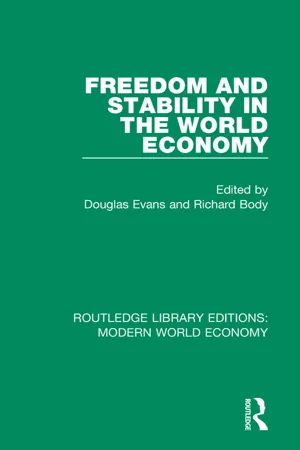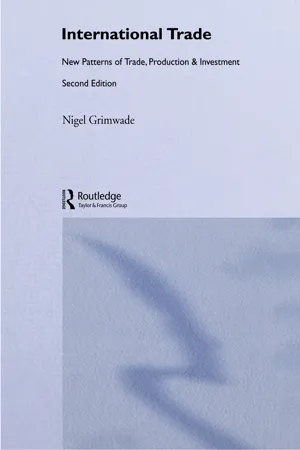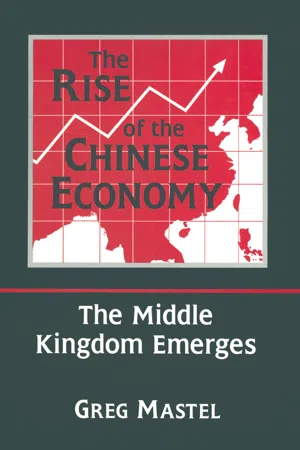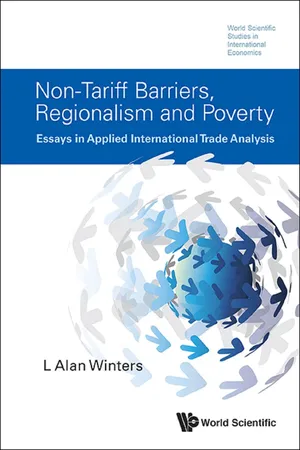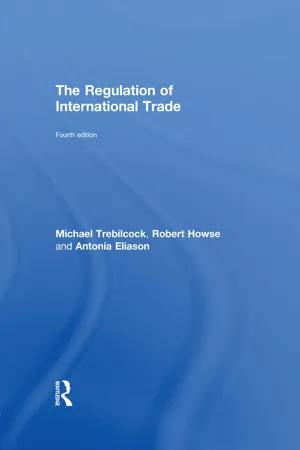Economics
Barriers to Trade
Barriers to trade refer to any government-imposed restrictions or obstacles that hinder the free flow of goods and services between countries. These barriers can take the form of tariffs, quotas, subsidies, or regulations, and are designed to protect domestic industries from foreign competition. By limiting imports, barriers to trade can impact consumer choices, increase prices, and reduce overall economic efficiency.
Written by Perlego with AI-assistance
Related key terms
9 Key excerpts on "Barriers to Trade"
- eBook - ePub
- Douglas Evans, Richard Body(Authors)
- 2017(Publication Date)
- Routledge(Publisher)
II ECONOMIC BARRIERS TO WORLD PROBLEMSPassage contains an image
DAVID ROBERTSON4. NON-TARIFF Barriers to TradeAs tariffs have been reduced by successive rounds of multilateral negotiations in the GATT, and selectively in discriminatory trade blocs, it has become apparent that other Barriers to Trade have become relatively more significant. These so-called non-tariff barriers are remarkable for their diversity, and in the eyes of some commentators they are now more important than remaining tariffs in their impact on trade flows. The wide variety of measures considered as non-tariff barriers has been most completely revealed in regional trade blocs, like the EEC and EFTA, where the elimination of tariffs has exposed these alternative instruments of protection. Some attempts have been made in these regional blocs to harmonise national policies to reduce the effects of non-tariff barriers. There is a danger, however, that this will intensify the trade-distorting effects on outsiders. Since non-tariff barriers exist in all countries, it would be more appropriate if attempts to modify or remove such trade-distorting policies took place in a multilateral framework.‘Non-tariff barriers’ is a collective term for the whole range of government policy measures and practices which operate deliberately, or sometimes only incidentally, to restrain imports or to distort exports. Some of these measures are specifically designed to impede imports, such as import quotas and customs administration charges. In addition, some imports are affected, perhaps unintentionally, by domestic laws and regulations, such as health and safety standards, trade-marking and local government procurement regulations. Trade patterns are also distorted by domestic assistance programmes, which not only help import-competing industries but also promote exports, as well as by measures aimed at subsidising exports through tax incentives and favourable financing. Thus, the term ‘non-tariff barriers’ comprises both trade restricting measures and trade promoting measures. (‘Non-tariff distortions’ has been suggested as a more accurate description,1 - eBook - ePub
How Developing Countries Trade
The Institutional Constraints
- Sheila Page(Author)
- 1994(Publication Date)
- Routledge(Publisher)
On other controls, stemming from internal national politics, the line between intent and effect is difficult to draw in theory, but in practice there have been surprisingly few disagreements on major trade flows. When they were first set up, mostly around 1980, official data collections were expected to be seriously biased downwards because of constraints on their ability to accuse governments of such transgressions and reluctance to include informal measures, but they have included the major private agreements (quotas among industries) or semi-trade barriers (on procurement). Private observers also hesitate before including barriers which are in many cases closer to the accepted country-specific advantages of a local producer over imports, in terms of familiarity with markets or suitable output patterns than to intentional discrimination against imports. A rigorous interpretation could lead to virtually all trade being called ‘managed’, in the sense that it is subject to familiarity with existing suppliers or markets, good will, legal norms, etc. This is a valid way of stressing the general market access problem for any new supplier, one which may well be particularly important for a developing country with many new suppliers, but it does not capture the real changes which have occurred and the continuing differences among markets and products in more formal and recorded barriers.The detailed discussion of types of quotas and other possible barriers is best treated on a country and sector basis, as the variants in type and implementation are extremely large in theory, and can give rise to extra-ordinarily complex classification schemes, but are considerably more manageable if individual cases are considered. What is important at the aggregate level is to indicate broad trends, differences over time among importing countries or among sectors, and the overall significance of non-tariff barriers in the context of international trade and of other types of policy intervention.That is the principal purpose of this chapter. But there are less quantifiable questions which need to be considered in assessing their level and their potential impact. In particular, much of the literature on their effects (and the quantification used in measuring them) sees them as substitutes for tariffs (it takes for granted the first of the explanations suggested at the beginning of this chapter). But this is in some ways the least plausible reason for using them: it is true that the GATT restricts tariffs, but it forbids (or has even stronger restrictions on) quotas, discrimination among suppliers, and the use of domestic regulations or taxes to discriminate against imports. Furthermore, many countries have national legislation as well, explicitly restricting the type of cartel which is required for intervention in trade by industrial groups (or directed at foreign sectors). - eBook - ePub
Economics for Investment Decision Makers
Micro, Macro, and International Economics
- Christopher D. Piros, Jerald E. Pinto(Authors)
- 2013(Publication Date)
- Wiley(Publisher)
Thus, in contrast with trade restrictions, which limit the openness of goods markets, capital restrictions limit the openness of financial markets. Sections 3.1 through 3.4 discuss trade restrictions. Section 3.5 briefly addresses capital restrictions. 3.1. Tariffs Tariffs are taxes that a government levies on imported goods. 13 The primary objective of tariffs is to protect domestic industries that produce the same or similar goods. They may also aim to reduce a trade deficit. Tariffs reduce the demand for imported goods by increasing their price above the free trade price. The economic impact of a tariff on imports in a small country is illustrated in Exhibit 8-12. In this context, a small country is not necessarily small in size, population, or GDP. Instead, a small country in this context is one that is a price taker in the world market for a product and cannot influence the world market price. For example, by many measures Brazil is a large country, but it is a price taker in the world market for cars. In this context, a large country, however, is a large importer of the product and can exercise some influence on price in the world market. When a large country imposes a tariff, the exporter reduces the price of the good to retain some of the market share it could lose if it did not lower its price. This reduction in price alters the terms of trade and represents a redistribution of income from the exporting country to the importing country. So, in theory it is possible for a large country to increase its welfare by imposing a tariff if (1) its trading partner does not retaliate and (2) the deadweight loss as a result of the tariff (see the following discussion) is smaller than the benefit of improving its terms of trade - eBook - ePub
International Trade
New Patterns of Trade, Production and Investment
- Nigel Grimwade(Author)
- 2020(Publication Date)
- Routledge(Publisher)
Despite the fact that free trade increases global economic welfare, most governments interfere in trade. Usually, the main reason for doing so is to grant protection to a particular industry threatened by foreign competition. Protection may take the form of imposing tariffs on imports or the creation of various kinds of non-tariff barriers. Trade may also be distorted by government measures that favour domestic producers over foreign producers (e.g. granting a subsidy to a domestic producer). In the next two sections of this chapter, the effects of these kinds of government interference in trade are examined. We begin with tariffs because they are perhaps the most obvious form of government-imposed barrier to trade.Tariffs may take the form of a specific duty payable on each unit imported or an ad valorem tariff expressed as a percentage of the unitBox 8.1 The Effects of Increased Trade: Inter- and Intra-Industry Specialisation ComparedThe Effects of Inter-Industry Specialisation
- Static effects - lower prices and improved resource allocation
- Dynamic effects
- Economies of large plant size
- Increased price competition
- Increased capital investment
- Increased rate of technological change
- Higher output due to higher real incomes
- Industry trade balances widen - may lead to resistance to lowering trade barriers in import-competing sectors
- Adjustment costs Need for inter-sectoral re-allocation of factors Need for relative factor prices to change (where factor intensities differ between export and import-competing sectors)
- Distributional effects - price of country's scarce factor may fall relative to price of country's abundant factor
The Effects of Intra-Industry Specialisation
- Static Effects
- More varieties of each type of good become available (love for variety)
- Consumers able to get a variety closer to their preferred type
- Some reduction in prices due to increased competition
- Dynamic Effects
- Scale economies due to more plant specialisation (long production runs)
- Learning by doing effects (dynamic scale economies)
- eBook - ePub
Trading with the Environment
Ecology, economics, institutions and policy
- Thomas Andersson, Carl Folke, Stefan Nystrom(Authors)
- 2013(Publication Date)
- Routledge(Publisher)
during the 1980s, despite the fact that the majority of the world s population and natural resources are located there. The situation is changing in the 1990s. The growing importance of the newly industrialized countries in East Asia, where success has sharply intensified competition within industry, has been obvious for years. Today, other parts of East Asia, including China and Vietnam, Latin America and even South Africa are attracting increased attention. The traditionally powerful economies of North America and Western Europe have lost their grip on the fastest expanding segments of world trade, and are seeking new ways to respond. The former planned economies of Eastern Europe have dropped back even more drastically, but there is hope that some of them can soon enter the group of successful, newly industrialized countries.Other forms of trade
Trade not only consists of a flow of goods and services that are exchanged between buyers and sellers in the international market place, but a large part of trade occurs within countries and is regulated by 'national trade barriers'. For example, various functional regulations, formal educational requirements, and so on act in reality as non-tariff trade barriers which influence international trade. While barriers at the border may give rise to smuggling, domestic trade barriers tend to result in tax evasion and growth of a black market. Furthermore, the line between national and international trade is blurred, as trade between regions in a country may be subject to the same limitations as trade between different countries. With the creation of customs' unions, single markets and currency unions, the decision-making responsibility for forming the regulations which govern trade is moving from the national to the international level.Trade also takes place over time, as is implicit in saving, investment and consumption decisions. Finally, there exist flows which are entirely or partially non-commercial, which implies that well-functioning markets do not exist. The result is that trade fails to come about, although transfers of resources do occur. As is discussed in the previous chapter, this is true for many environmental effects, which take the form of externalities and fall outside the market.83 - eBook - ePub
The Rise of the Chinese Economy: The Middle Kingdom Emerges
The Middle Kingdom Emerges
- Greg Mastel(Author)
- 2016(Publication Date)
- Routledge(Publisher)
China Business Review (March/April 1995), 35-38.40. William R. Cline, The Future of World Trade in Textiles and Apparel (Washington, DC: Institute for International Economics, 1990).41. "China: U.S. Customs Says Illegal Textile Transshipments Are Larger than Original $2 Billion Estimates." SAM Trade (May/June 1995), 13.42. Daniel Southerland, "U.S., China Sign Prison Labor Pact," Washington Post, August 8, 1992.43. United States Trade Representative, 1996 National Trade Estimate Report on Foreign Trade Barriers (Washington, DC: USTR, 1996), 40.Passage contains an image
6 Trade BarriersFormal trade barriers, like tariffs, quotas, and import licenses, are the most visible impediment to free economic interchange with China. In practical terms, it is almost impossible to disentangle the problems caused by trade barriers from those related to the sweeping powers of the totalitarian government or the limitations on foreign currency exchange. The limitations on trading rights, for example, which were discussed in the context of the totalitarian government system in China, are also formal trade barriers. Similarly, the administered import demand procedures are implemented through formal trade barriers.Chinese trade barriers not only duplicate the effects of other policies, they also duplicate other trade barriers. The entire Chinese trade regime is characterized by multiple layers of duplicative trade barriers. It is not unusual for imports of a particular product to be blocked by a prohibitive tariff, an administrative import quota, import licenses, and a restrictive certification regime. Individually, any one of these barriers would be sufficient to exclude imports from China. Often the differing levels of protection are the result of different Chinese ministries seeking authority over import decisions.The overlapping barriers do, however, make trade, trade negotiations, and the task of trade liberalization quite complex. As was noted previously, the problem is similar to that with Japan; the layering of trade barrier upon trade barrier makes the task of opening the market much like the task of peeling an onion—peeling away one layer merely reveals another. Thus, a trade agreement that merely removes one barrier has almost no practical effect upon trade. - eBook - ePub
Non-tariff Barriers, Regionalism And Poverty: Essays In Applied International Trade Analysis
Essays in Applied International Trade Analysis
- L Alan Winters(Author)
- 2015(Publication Date)
- WSPC(Publisher)
Part A
Non-Tariff Barriers
Passage contains an image THE WORLD BANK ECONOMIC REVIEW, VOL. 1, NO. 1: 181–199
The Extent of Nontariff Barriers to Industrial Countries’ Imports
Julio. J. Nogués, Andrzej Olechowski, and L. Alan Winters This article examines the extent of nontariff barriers (NTBS ) to the visible imports of sixteen industrial countries. It uses three alternative measures to show that governmental commodity-specific border measures affect more than 27 percent of all imports and more than 34 percent of imports from developing countries. It also shows that during the period from 1981 to 1983, NTBS became significantly more extensive. Detailed statistics reveal considerable variations in NTB coverage by commodity, type of barrier, importer, and exporter. The data on which these conclusions are based were compiled from official information at the highest level of disaggregation and are described in the article.Since the 1940s, considerable progress has been made in liberalizing tariff barriers to international trade through a series of multilateral negotiations. For example, the Tokyo Round of the General Agreement on Tariffs and Trade (GATT ) concluded in 1979 with an agreement to lower industrial countries’ tariffs by about 25 percent on average, and the Geneva (1956), Dillon (1962), and Kennedy rounds (1968) produced similar reductions. In consequence, the average tariff level of industrial countries was reduced from about 40 percent in the mid-1930s to 4–8 percent after the Tokyo Round.As the GATT rounds have brought about a significant decline in tariff obstacles to trade, nontariff barriers (NTBS ) have become more prevalent. The GATT specifically allows countries to impose several kinds of measures, for example, safeguard and antidumping restrictions and countervailing duties. In addition, governments and import-competing interests have been quite inventive in expanding trade barriers. These restrictions have come about through the development and implementation of restrictions which are outside the GATT , such as “voluntary” export restraints, and through the addition of provisions to the GATT to sanction widespread restrictions, including those on agricultural products when the GATT - eBook - ePub
The Regulation of International Trade
4th Edition
- Robert Howse, Antonia Eliason(Authors)
- 2013(Publication Date)
- Routledge(Publisher)
7 Border measures
Tariffs and quantitative restrictions
TARIFFS OVERVIEW
Tariffs are essentially taxes on imported goods, and they, as well as other customs duties, must be applied in accordance with the Most Favoured Nation (MFN) principle discussed in Chapter 2 of this book. Additionally, WTO Members may, but are not obligated to, commit to binding certain customs duties that may generally be understood as committing to maximum duties for particular products.1 Binding is in accordance with the object and purpose of both the WTO Agreement and the GATT 1994. These two Agreements in their respective preambles recognize the desirability of ‘reciprocal and mutually advantageous arrangements directed to the substantial reduction of tariffs and other Barriers to Trade’. Members’ commitments vary, are usually the product of multilateral trade negotiations, and are included in schedules of concessions which may be found in the annexes of the GATT.THE ECONOMIC EFFECTS OF A TARIFF
The economic effects of a tariff on both importing and exporting countries are best understood by first examining the case of a prohibitive tariff, a tariff that is so high that it prevents all imports. Here we draw on an example provided by Ruffin and Gregory.2 (See Figure 7.1 .)With a prohibitive tariff, the prices paid for shirts in each country are determined by the supply and demand curves in each country. To compare prices, we assume that US$2 = £1. If there was no tariff, prices would be the same in the two countries. The prohibitive tariff in America raises the price in America from US$6 to US$9. Consumers lose area A + B, but producers gain area A. The net loss to America is area B. In the UK, prices fall from £3 to £2, and producers lose area C + D, while consumers gain C. The gain to consumers is less than the loss of producers. The net loss to Europe is area D.One can next consider a non-prohibitive tariff, which does not preclude all imports of a product. Ruffin and Gregory graph this example as in Figure 7.2 . Before the nonprohibitive tariff, the price of the product is Pw . The tariff raises the price to Pw + T which is the world price plus the amount of the duty. Consumers lose area N + R + T + V. Producers gain N. The government gains the tariff revenue T, which equals the tariff per unit times the quantity of imports. The net loss is R + V. The tariff lowers imports from (q4 – q1 ) to (q3 – q2 - eBook - ePub
European Economic Integration
Limits and Prospects
- Miroslav Jovanovic(Author)
- 2002(Publication Date)
- Routledge(Publisher)
The government collects tariff revenue equal to CT×Q 3 Q 4. This choice by country A may be questioned. There are at least two good reasons to object to trade restrictions in the medium and long term. First, new Barriers to Trade can provoke retaliation from foreign countries where domestic exporters intend to penetrate. Second, and more subtle, if intermediate goods exist, all trade barriers raise the price of imported inputs. Therefore, they act as a tax on exports. 6 With the tariff, country A employs more resources in an industry in which it does not have a comparative advantage. Bearing in mind the assumption that the amount of resources is fixed and stepping out shortly from the partial equilibrium model, the fact is that resources are diverted away from business activities in which this country may have a comparative advantage. If a home industry is not competitive, a tariff may save jobs in this business in the short term. This may, however, lead to reduced activity in other home industries. If the uncompetitively produced home good is an input in other industries, their export performance may be compromised and investment reduced with the overall consequence of increased unemployment in the longer term. Policy-makers can easily identify jobs that are saved by various forms of protection, but they do not easily recognize the adverse consequences of this protection, hence the need for a general equilibrium model. Through protection in the long term, resources are wasted on inefficient production. Everybody loses except the government (because of increased revenues) and the protected industry. In the short run the problem is that the general equilibrium consequences of a given policy are not easily quantifiable
Learn about this page
Index pages curate the most relevant extracts from our library of academic textbooks. They’ve been created using an in-house natural language model (NLM), each adding context and meaning to key research topics.
